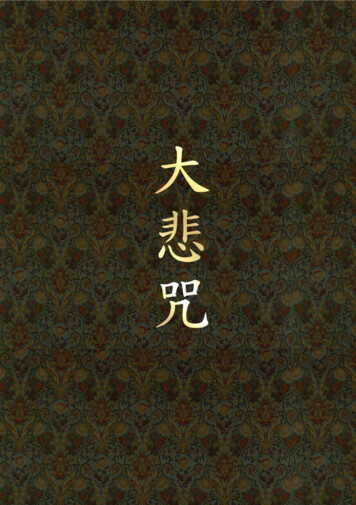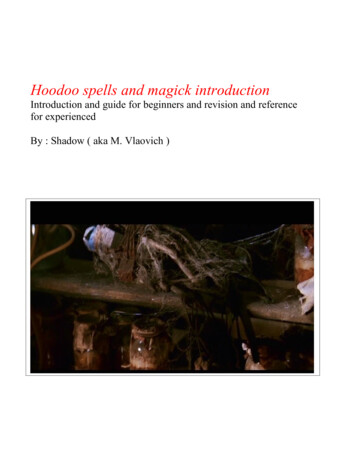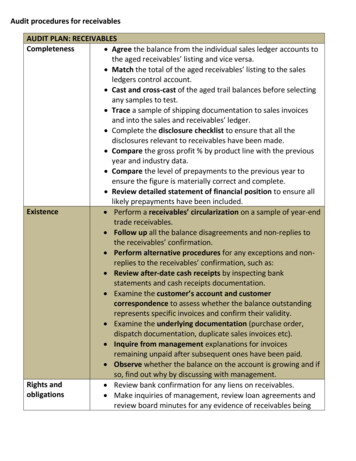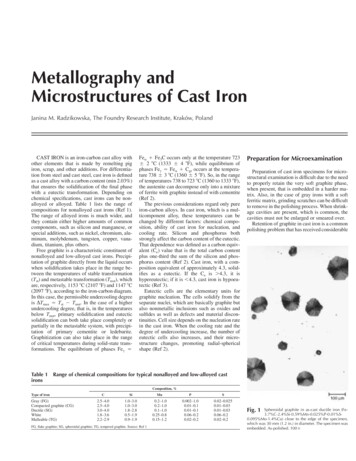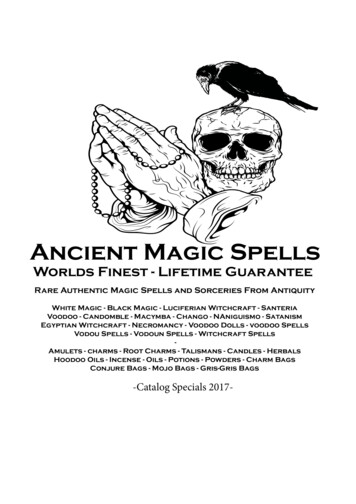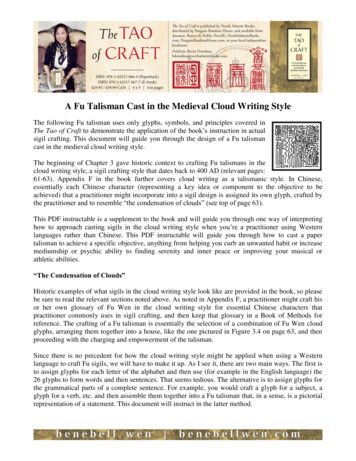
Transcription
A Fu Talisman Cast in the Medieval Cloud Writing StyleThe following Fu talisman uses only glyphs, symbols, and principles covered inThe Tao of Craft to demonstrate the application of the book’s instruction in actualsigil crafting. This document will guide you through the design of a Fu talismancast in the medieval cloud writing style.The beginning of Chapter 3 gave historic context to crafting Fu talismans in thecloud writing style, a sigil crafting style that dates back to 400 AD (relevant pages:61-63). Appendix F in the book further covers cloud writing as a talismanic style. In Chinese,essentially each Chinese character (representing a key idea or component to the objective to beachieved) that a practitioner might incorporate into a sigil design is assigned its own glyph, crafted bythe practitioner and to resemble “the condensation of clouds” (see top of page 63).This PDF instructable is a supplement to the book and will guide you through one way of interpretinghow to approach casting sigils in the cloud writing style when you’re a practitioner using Westernlanguages rather than Chinese. This PDF instructable will guide you through how to cast a papertalisman to achieve a specific objective, anything from helping you curb an unwanted habit or increasemediumship or psychic ability to finding serenity and inner peace or improving your musical orathletic abilities.“The Condensation of Clouds”Historic examples of what sigils in the cloud writing style look like are provided in the book, so pleasebe sure to read the relevant sections noted above. As noted in Appendix F, a practitioner might craft hisor her own glossary of Fu Wen in the cloud writing style for essential Chinese characters thatpractitioner commonly uses in sigil crafting, and then keep that glossary in a Book of Methods forreference. The crafting of a Fu talisman is essentially the selection of a combination of Fu Wen cloudglyphs, arranging them together into a house, like the one pictured in Figure 3.4 on page 63, and thenproceeding with the charging and empowerment of the talisman.Since there is no precedent for how the cloud writing style might be applied when using a Westernlanguage to craft Fu sigils, we will have to make it up. As I see it, there are two main ways. The first isto assign glyphs for each letter of the alphabet and then use (for example in the English language) the26 glyphs to form words and then sentences. That seems tedious. The alternative is to assign glyphs forthe grammatical parts of a complete sentence. For example, you would craft a glyph for a subject, aglyph for a verb, etc. and then assemble them together into a Fu talisman that, in a sense, is a pictorialrepresentation of a statement. This document will instruct in the latter method.
To start, define your objective. What is it you want your Fu talisman to achieve? Write it out in longform below. The free-write will help you conceive the necessary glyphs later on.From what you have written above, identify a primary subject, which is likely to be you or the name ofthe beneficiary. (Beneficiaries are explained in Note 14 of the endnotes on page 539; it is firstreferenced on page 97 and further explained beginning on page 221.)Seeking inspiration and guidance from the phrase “like the condensation of clouds,” hand-draw aglyph to represent each of the four concepts noted below that make up your specific intent or objective.SubjectVerbObjectAdverbial PhraseGlyph representing your nameor name of the beneficiary.Assert the desired action to betaken. What action will the Fusigil trigger?Person or thing affected by theaction described in the verb.How the action in the verb willbe executed. E.g., timing,location intentions, etc.Here is an example to demonstrate. The defined objective is for John Doe to gain access and entry intothe Celestial Ninth Kingdom (hypothetical non-physical realm) by invoking Delta Deva (hypotheticalname of a divine spirit I made up for this example).John DoeAccess / EntryCelestial Ninth KingdomInvoking Delta Deva
Next, assemble the four cloud glyphs into the below recommended arrangement. The circle-connectedby-lines house or framework is inspired by Fu sigils featured in the Taoist Canons, circa 400 A.D. SeeFigure 3.4, page 63 for a historic example. In the top left, put the Subject; top right, Verb; bottom leftis the Object; bottom right is the Adverbial Phrase.In the hypothetical given for demonstration, here is what the completed Fu sigil might look like:
Below represents an alternative arrangement for the sigil. This house for the sigil is based on theontological trinity, noted on page 90 of the book and illustrated in Figure B.25 on page 343. From topto bottom, arrange the Subject, Verb, Object, and Adverbial Phrase glyphs you created.
Note that the boxes in the provided template diagrams are for reference only. The completed sigilwould not have any boxes. Be sure to erase or remove the boxes from the final draft of your sigil. Inthe below example, yin and yang (or more specifically, yang) amplifiers are added. Refer to thediscussion starting on page 91 and corresponding with Figure 4.24 in the book. Here, eleven yangamplifiers are added, with the numerology of eleven corresponding with the heavenly or celestialrealms, which supports John Doe’s objective for the talisman.Illustrated examples of the hypothetical sigil to be crafted.Above right shows the sigil stamped with the (here, fictional) practitioner’s seal.A Lo Shu Arrangement for a General Luck TalismanRecall the Lo Shu Nine-Sector Magic Square explained in the section starting on page 28 of the text.Also see Figure 1.19 on page 30 and Figure 8.7 on page 202 for further reference. The below Lo Shuarrangement for a general luck talisman is based on the metaphysical correspondences of the Lo Shumagic square, which is covered in detail in the book, so let’s get straight to the craft. The house orframework incorporates the eight trigrams of the Ba Gua in the Later Heaven arrangement, see pages23-28 to refresh your understanding of the Ba Gua.
You will design a total of nine glyphs, or Fu Wen, in the cloud writing style and arrange it into theabove structure in accordance with the nine sectors of the Lo Shu. For each sector, design a cloud-styleglyph that represents your objective, desire, or highest goal for that corresponding area of life.For example, the top left sector of the nine sectors pictured corresponds with the southeast, or the LoShu sector for your personal wealth, resources, assets, financial health, and money matters. So design aglyph in the cloud style that represents your financial goals. The left center sector corresponds withfamily, ancestry, and one’s foundations. This can relate to contact with ancestors, desiring health andhappiness for your family, etc. Continue for all nine sectors. Below is an example of a completed sigil
in the cloud writing style per the Lo Shu arrangement. Remember: the “squares” appearing in theprevious diagram were for reference only. Your completed sigil should omit the reference squares.Sample Custom Designed General Luck Talisman in the Lo Shu ArrangementLo Shu Arranged Cloud Script Talisman Stamped with Practitioner’s Seal
Practice TipNote Appendix B, the Glyph Design References. Design Fu Wen or a glyph in the cloud writing stylefor each of the characters, phrases, or deities that resonate with you and draw it into the book next tothe corresponding entry for future references. Alternatively, they can be compiled into your personalgrimoire. See below book page spread from Appendix B for an example of how you might do this.In the above sample page spread, the practitioner has written in the Chinese oracle bone script for each character to theleft, for future use in sigil crafting, and a personally designed glyph in the cloud writing style to the right of each entry.The Tao of CraftTo learn more about the history and cultural practice of Fu talismans and sigil crafting in the Easternesoteric traditions, get your copy of The Tao of Craft: Fu Talismans and Casting Sigils in the EasternEsoteric Tradition (North Atlantic Books, 2016).
The completed sigil would not have any boxes. Be sure to erase or remove the boxes from the final draft of your sigil. In the below example, yin and yang (or more specifically, yang) amplifiers are added. Refer to the discussion starting on page 91 and corr



